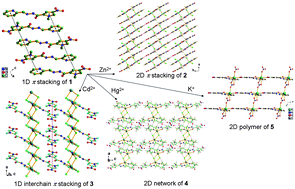A novel asymmetric N-heterocyclic ligand, 1·H2O [1 = (E)-1-methyl-4-nitro-N′-(pyridin-2-ylmethylene)-1H-pyrrole-2-carbohydrazide], was generated by a facile route, and some closed shell metal complexes of the ligand were also synthesized. These complexes include [Zn(1)Cl2] (2), [Cd(1)(μ-Cl)2]n (3), [Hg(1)Cl2] (4) and [K(μ-1)(μ-NO3)]n (5), which were characterized by X-ray crystallography, IR and 1H-NMR spectroscopy, and elemental analyses. The structural studies indicate that ligand 1, with its different conformations and new coordination modes, is an important building block for designing and constructing supramolecular structures via π⋯π stacking, hydrogen bonding, Cl⋯Cl and d10–d10 interactions. These interactions not only reinforce the stability of structures, but also correlate with the physical properties of complexes. The UV and fluorescence spectral properties were investigated in solution. The titration experiments by d10 metal ions imply that ligand 1 forms stable complexes at a 1 : 1 ratio and exhibits enhanced fluorescence. Moreover, compared with the solution fluorescence spectra, the solid-state spectra show more significant red-shifts, suggesting that complexes 2–4 have possible applications as light emission materials.
